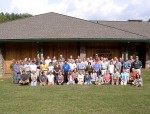OBFS encourages LTER participation in field station network.
At a recent annual meeting of the Organization of Biological Field Stations (OBFS) co-hosted by Coweeta Hydrologic Laboratory and Highlands Biological Station in western North Carolina (see photo), several participants noted the benefits of collaboration, and urged additional representation in OBFS of LTER sites that conduct research and educational activities at field stations. OBFS is an energetic and growing network of field stations that was founded in 1967. Its 162 field stations and 28 individual members cover most parts of the United States, in addition to 23 international field station members.
The 2005 Organization of Biological Field Stations annual meeting was co-hosted by Coweeta Hydrologic Laboratory and Highlands Biological Station in western North Carolina. Photo by Kathy Flowers
The OBFS mission is "to serve the member stations in ways that increase their effectiveness in research, education, and outreach." The organization's recently completed strategic plan, funded by the National Science Foundation, identified seven goals to serve this mission, and created seven task forces to achieve these goals. For more information about OBFS, its strategic plan, and online maps showing the location of member field stations, please visit the OBFS website, www.obfs.org.
A number of LTER sites are long-standing members of OBFS and actively support the mission of the organization through research, education, and the proposal review process. These sites also benefit from improved infrastructure through the use of funding from the National Science Foundation Field Station and Marine Laboratories (FSML) program (http://www.nsf.gov/pubs/2005/nsf05550/nsf05550.htm).
After the September 2005 OBFS meeting, we compiled Table 1 showing the current LTER site membership in OBFS. We found that 10 of the 26 LTER sites are current members and that five of those members routinely send representatives to the OBFS annual meeting. Several LTER field stations have also hosted recent OBFS annual meetings including Andrews LTER in 2000, Kellogg LTER in 2002, and Coweeta LTER in 2005.
Table 1. Summary of LTER site involvement with the Organization of Biological Field Stations as of October 2005.
| LTER sites that are members of OBFS | LTER sites that routinely send representatives to the OBFS annual meeting | LTER sites encouraged to become OBFS members |
| AND, ARC, CWT, HBR, KBS, KNZ, NTL, SEV, SGS, VCR | AND, CWT, HBR, KBS, SEV | BES, BNZ, CAP, CCE, CDR, FCE, GCE, HFR, JRN, LUQ, MCM, MCR, NWT, PAL, PIE, SBC |
| Total = 10 | Total = 5 | Total = 16 |
LTER sites that are members of OBFS enjoy several benefits:
- Direct access to NEON representatives at the OBFS annual meeting
- Increased collaboration and linkages with other field stations conducting similar research and education programs
- New ideas and approaches to the administrative challenges that many field stations face as a result of insufficient funding, increased usage, and distant locations from their parent institutions
- Direct access to and presentations from NSF representatives from the FSML program and other NSF programs represented at the annual meeting; and
- Participation in Congressional Visits Day organized by the American Institute of Biological Sciences (AIBS), with financial support from OBFS, and arrangements to meet members of Congress from your district.
We also have found that increased collaboration among all sizes of field stations provides them greater coverage of the ecosystems in their region and increases their resources to compete more effectively for new funding sources such as NEON. These collaborations can be built partly as a result of scientific, educational, and personal projects developed at OBFS meetings.
If your LTER site is not a member or not actively participating in OBFS, we encourage you to seek further information from the OBFS web site, or to contact one of the authors for further information. Our next annual meeting will be held 14-17 September 2006 and will be hosted by Flathead Lake Biological Station located in the Rocky Mountains near Glacier National Park in Montana. We invite all LTER sites to join OBFS, attend our meetings, and to further develop the linkages between the OBFS and LTER networks.
Brian Kloeppel (CWT), Renee Brown (SEV), Nina Consolatti (KBS), James Costa (Highlands Biological Station), Ian Halm (HBR), Claudia Luke (UC Davis Bodega Marine Reserve), William Michener (LNO), Don Natvig (SEV), Kari O’Connell (AND), Sedra Shapiro (San Diego State University Field Station Programs), Larry Weider (University of Oklahoma Biological Station), Marshall White (LNO), and Robert Wyatt (Highlands Biological Station)

 Enlarge this image
Enlarge this image